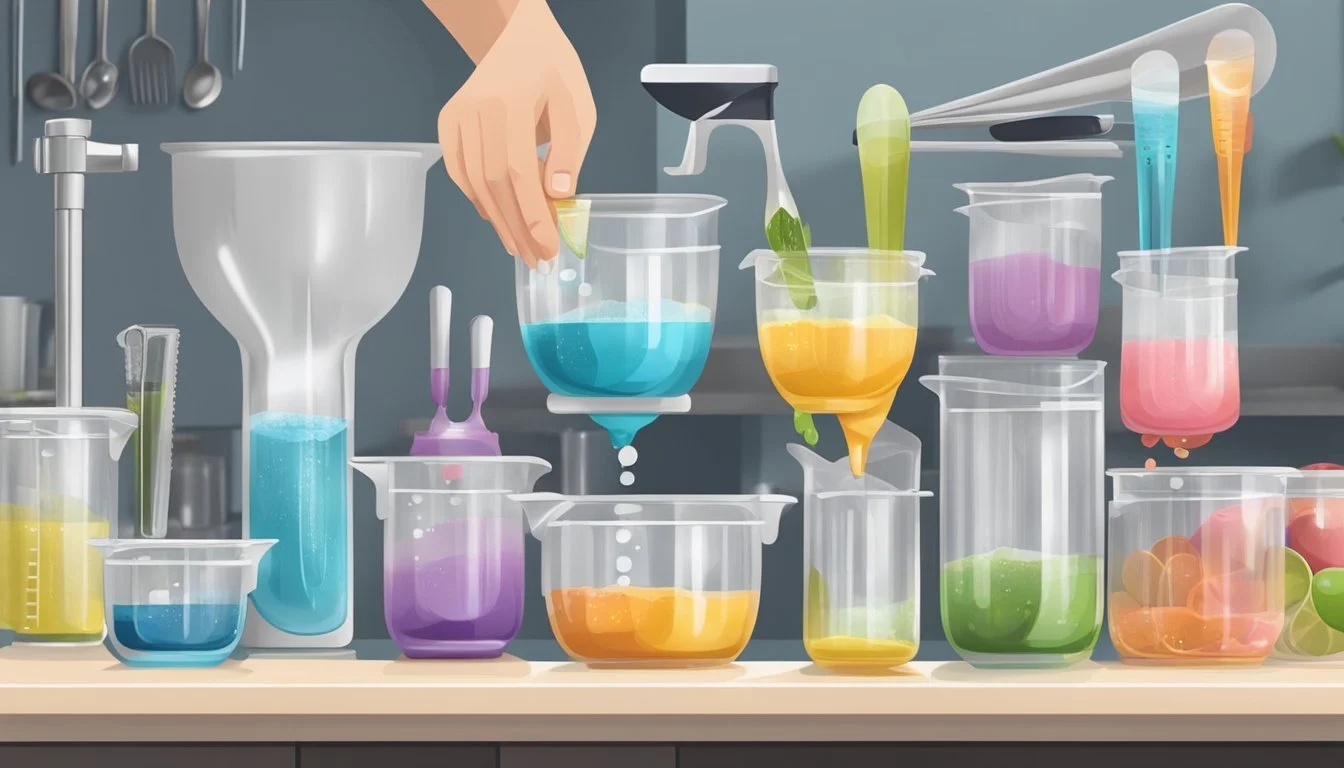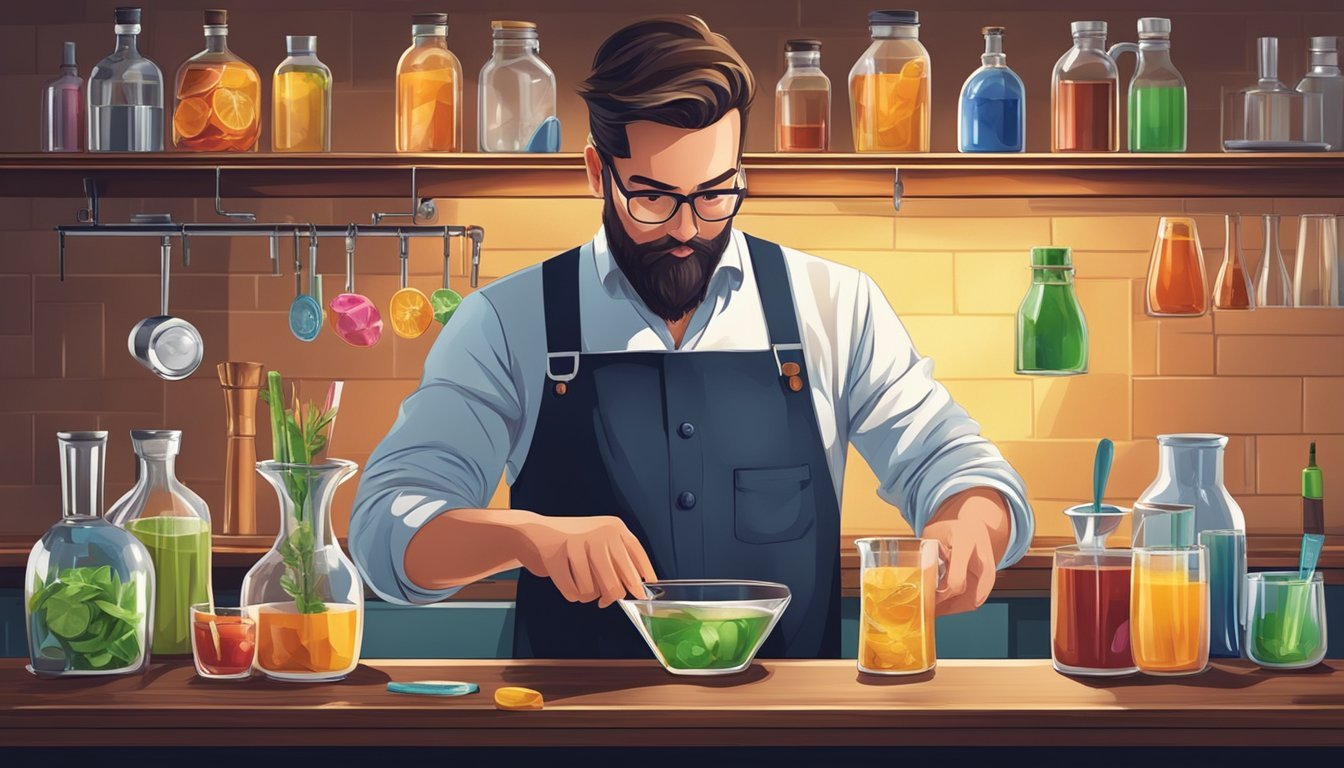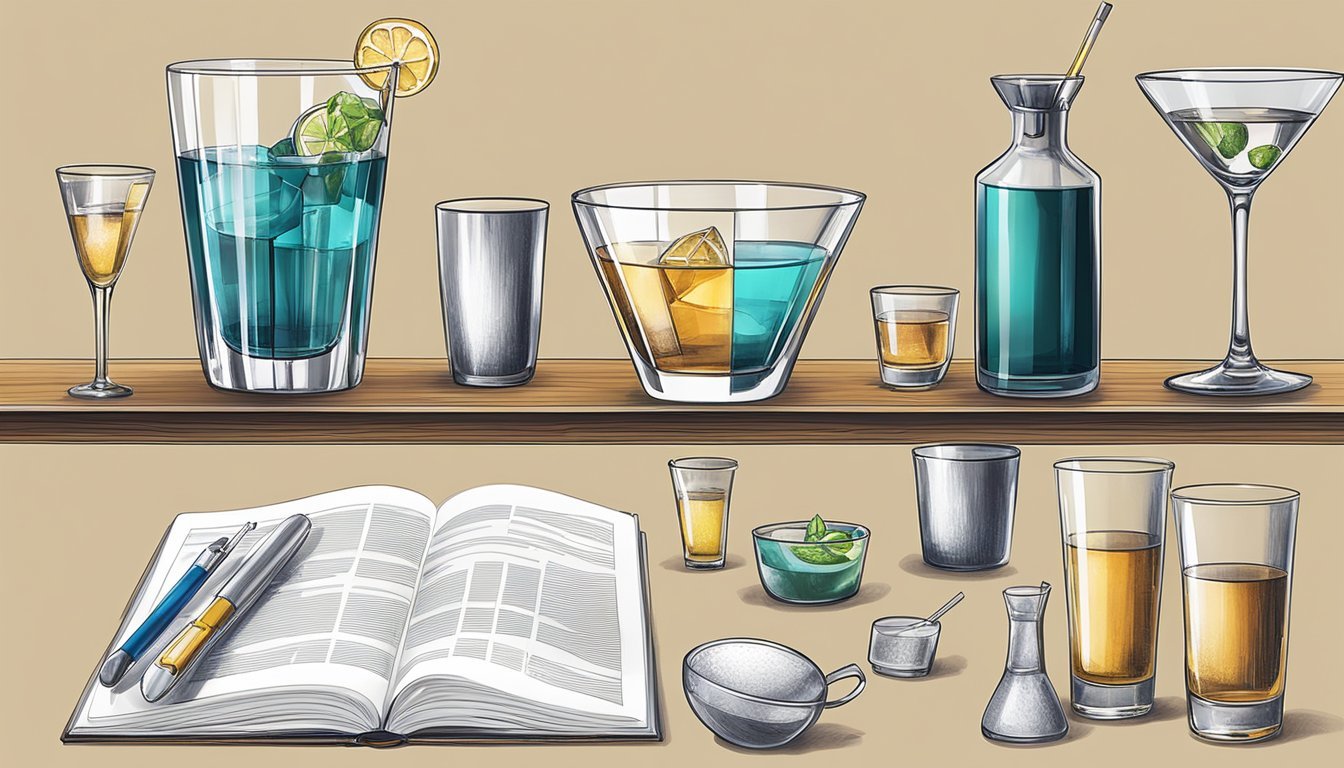Understanding the Measurements in a Standard Cocktail Recipe
Mastering Mixology Fundamentals
Crafting the perfect cocktail is both an art and a science. It requires a precise blend of ingredients to achieve the flavor profile and potency desired. Standard cocktail recipes operate on a set of common measurements to ensure consistency and balance in every glass. These measurements, often listed in ounces or milliliters, serve as a guide to mixologists and home bartenders alike, helping to maintain the integrity of a cocktail's taste and strength.
Understanding how to measure ingredients accurately is fundamental in cocktail making. The fluid ounce, a unit of volume commonly used in the United States, is a standard measure in cocktail recipes, with one fluid ounce equaling approximately 30 milliliters. A typical recipe might call for a range of 1.5 to 2 ounces of alcohol, depending on the desired outcome. A 'shot' generally equates to one fluid ounce, while a 'jigger' – another term frequently found in recipes – holds 1.5 fluid ounces. Recognizing these terms and their conversions ensures that each component of the cocktail contributes to the intended flavor without overpowering it.
Measuring tools such as jiggers, measuring spoons, and graduated cups are vital for accuracy. While professional bartenders may measure by eye or count, precision is advised, especially for those less experienced. Additionally, the concept of 'parts' used in some recipes allows for scalability, maintaining the ratio of ingredients regardless of the serving size. This system adapts easily for single servings or large batches, ensuring that every sip delivers the signature taste and quality of the cocktail as originally designed.
Understanding Recipe Measurements
In cocktail preparation, accurate measurements ensure the intended flavor balance and strength of the drink. This section will review the significance of measurement precision and the common units used in cocktail recipes.
The Importance of Precision
Precision in cocktail measurements is crucial because it guarantees consistency. A well-crafted cocktail requires exact proportions of each ingredient to achieve the desired taste and potency. Even slight deviations can result in a cocktail that tastes off or differs from one serving to the next. Bars and mixologists aim for precise measurements to maintain the integrity of their recipes.
Common Measurement Units Used
Cocktail recipes often use a mix of metric and imperial systems for measuring liquids. Familiarity with both systems is important for accurate preparation.
Metric System:
Milliliters (ml)
Centiliters (cl)
Liters (l)
Imperial System:
Ounces (oz)
Fluid ounces (fl oz)
Conversion between these units is a key skill. Here is a basic table for reference:
Volume Milliliters (ml) Centiliters (cl) Ounces (oz) Fluid Ounces (fl oz) 1 ml 1 0.1 0.0338 0.0338 1 cl 10 1 0.338 0.338 1 oz 29.57 2.957 1 1 1 fl oz 29.57 2.957 1 1
The standard measurements in a cocktail recipe may also be listed as 'parts', which relies on relative measures rather than specific volumes. This allows for scaling of recipes to different sizes. Commonly used terms like 'shot' typically refer to 1 fluid ounce in the U.S. but can vary by country, reinforcing the importance of understanding standard measurements and conversions.
Measuring Ingredients
When preparing cocktails, the precise measurement of ingredients is crucial to achieving the intended flavor balance. Exact volumes of spirits, mixers, and other additions make the difference between a good cocktail and a great one. Different tools can assist in measuring these components accurately.
Using Jiggers and Shot Glasses
A jigger is a standard bartending tool with a dual-ended design, offering two different measurement capacities. Typically, one end holds a standard jigger volume of 1.5 fluid ounces (oz), which is approximately 44 millilitres (ml). The other end usually measures a smaller volume, often 1 oz (30 ml), aligning with the average shot glass.
Jiggers can come in various sizes beyond the standard, such as the double jigger which might hold 2 oz (59 ml) at one end. They ensure precision when a recipe calls for specific amounts like half ounces or quarters.
Shot glasses in the United States often represent a more casual measuring tool. They can vary in volume but commonly hold 1 oz or 1.5 oz. However, shot glasses are not as precise as jiggers, since their volume isn't always calibrated for exact measurements.
Tool Volume(Oz) Volume(ml) Standard Jigger 1.5 oz 44 ml Small Jigger End 1 oz 30 ml Double Jigger 2 oz 59 ml Shot Glass 1-1.5 oz 30-44 ml
Alternative Measuring Tools
For those without jiggers or shot glasses, other kitchen measuring tools can provide accuracy. A measuring cup or cocktail beaker with volume markings in both the metric system and ounces caters to multiple measurement preferences.
Teaspoons (tsp) and tablespoons (tbsp) are more often used for non-liquid ingredients like sugar or bitters. Generally, 1 teaspoon equates to around 5 ml, and 1 tablespoon corresponds to about 15 ml, which can also equate to half an oz.
Some bartenders utilize pour spouts and free pour techniques, which rely on counting or experience to estimate volumes. While these methods can be efficient, they lack the exactness of physical measuring tools and are less suitable for novice mixologists.
Unit Equivalent 1 Teaspoon (tsp) ~5 ml 1 Tablespoon (tbsp) ~15 ml
The easy jigger is a relatively new tool that combines the accuracy of a jigger with the speed of a free pour. It comes marked with different volume lines to make measurement fast and accurate for making cocktails.
Understanding and using these measuring tools contributes significantly to a cocktail's consistency and quality. Proper measurement respects the craft of cocktail making and ensures that each drink meets the creator's intended taste profile.
Standard Cocktail Measurements
Understanding the precise application of measurements ensures balance and consistency in cocktail recipes. Successful mixing begins with mastering volume to parts conversions, followed by the effective application of these measurements.
Volume to Parts Conversion
In cocktail making, the concept of "parts" simplifies the process of scaling recipes. One "part" can be any measure of volume, with other ingredients proportioned accordingly. This allows for flexibility in recipe size while maintaining balance.
Common Measurements and Their Conversions:
1 shot: 1 fluid ounce (oz) or 30 milliliters (mL)
Double shot: 2 fluid ounces (oz) or 60 milliliters (mL)
Jigger (used as a standard measure in many recipes): 1.5 fluid ounces (oz) or 44 milliliters (mL)
Conversion Table:
Measure Ounces (oz) Milliliters (mL) 1 part Variable Variable 1 shot 1 30 Double shot 2 60 Jigger 1.5 44
Applying Measurements to Cocktail Recipes
When applying measurements to cocktail recipes, bartenders should consider the ratio of one liquid to another to achieve the desired taste profile. A single unit of measure, such as a shot of vodka, can be used to create a balanced and proportionate drink when combined with other ingredients at appropriate ratios.
Example of a Simple Recipe Using Parts:
Three parts prosecco: 90 mL (if one part is 30 mL)
Two parts Aperol: 60 mL
One part soda water: 30 mL
This ratio maintains the harmony between the bitterness of Aperol, the sweetness of Prosecco, and the dilution of soda water. It's essential for bartenders to use consistent units of measurement to replicate the intended flavor profile of any cocktail.
Bartending Techniques
In the world of bartending, precision is key, whether one is free pouring or measuring with tools. A bartender's ability to consistently create balanced cocktails is a fundamental skill underpinned by various techniques, ranging from handling liquid ingredients to understanding the influence of ice on measurements.
Free Pouring and Its Precision
Free pouring is a technique where the bartender pours spirits or mixers directly from the bottle without using a physical measure. To ensure accuracy, they may count in seconds—usually, a one-second count equates to approximately 0.5 ounces. Bartenders often rely on muscle memory and a steady hand to achieve reproducible results. While free pouring can improve speed and efficiency, especially during peak hours, it requires extensive practice to maintain precision.
Standard Free Pour Count:
1 second = ~0.5 oz
2 seconds = ~1 oz
3 seconds = ~1.5 oz
4 seconds = ~2 oz
It's important to note that free pouring relies heavily on the skill and experience of the bartender. For those perfecting this method, practice with water is encouraged before attempting pours with actual spirits.
The Role of Ice in Measurements
Ice does more than simply chill a drink; it is a critical component that contributes to its final volume. When bartenders measure ingredients, they must account for the amount of ice that will be added to the glass or shaker. More ice reduces the room for liquid, thus one must measure ingredients accordingly. Moreover, as ice melts, it dilutes the cocktail, which can affect both taste and strength. Bartenders need to consider the size and shape of ice, and how quickly it will melt within a specific drink.
Ice Considerations:
Size: Larger blocks melt slower, reducing dilution.
Shape: Certain shapes, like spheres or large cubes, are optimal for spirits served over ice.
Quality: Clear, high-quality ice not only looks better but also melts more slowly.
Managing the dilution through ice is what differentiates a mixologist from an amateur. Thereby, it is crucial for a bartender to understand the role of ice in their measurements to ensure that every cocktail is served at its intended taste profile and temperature.
Glassware and Presentation
In crafting cocktails, the choice of glassware not only impacts the drink's aesthetic allure but also its flavor and temperature retention. The correct measurement of ingredients is essential for the intended taste profile.
Choosing the Right Glass
Different cocktails require specific types of glassware to enhance both the presentation and the sensory experience. For instance, a martini is best served in a stemmed martini glass which maintains the drink's coolness. In contrast, a pitcher is suitable for serving larger quantities, ideal for groups. A quart sized container, typically equating to roughly two pints, may also determine the type of glassware chosen based on the volume of the cocktail being served.
Old Fashioned: Short, wide tumbler; ideal for muddled cocktails with room for ice.
Highball: Tall and narrow; suitable for drinks served with a larger proportion of non-alcoholic mixer.
Flute: Tall and thin; preserves carbonation, perfect for champagne-based cocktails.
Presentation and Measurement
The precise measurement of ingredients is not just about taste but also impacts presentation. A splash or splashes of a mixer or liqueur can dramatically alter the color and layers in a drink, which is integral to its visual appeal to align with personal taste.
Examples of Measurements:
Alcohol Base: Typically 1.5 to 2 ounces
Juices/Syrups: Often measured in fractions of an ounce
Splash: A rough measure, roughly 1/6 ounce, used for adding a quick burst of flavor or dilution
The presentation is also dictated by the method of pouring and layering ingredients, which can showcase the bartender's skill and the complexity of the drink.
Mixing and Dilution
Effective mixing and dilution are crucial to achieve the right balance and flavor in a cocktail. These processes can significantly influence the final taste and consistency of the drink.
Influence of Syrups and Mixers
Mixers and syrups, like simple syrup, tonic, or cranberry juice, add both flavor and volume to cocktails. Simple syrup, a solution of sugar and water, should be added with precision, typically by the teaspoon, to avoid oversweetening. For example, a Margarita may require just a splash of simple syrup to complement the tartness of the lime juice and the sharpness of the triple sec.
Cranberry Juice: Useful for both flavor and color, usually measured in ounces or parts depending on the recipe.
Tonic: Often used in drinks like a vodka or gin tonic, where it is crucial to pair the bitterness of the tonic with the right amount of spirit.
Consistency in Cocktail Making
Consistency is imperative for professional cocktail making, both in mixing and in the quantities of each ingredient. Most recipes will call for specific measurements:
Spirits like gin or vodka are typically added in ounces or milliliters.
Bitters, potent and flavorful, are generally added in dashes—a bartender's equivalent to a pinch in cooking.
A standardized approach, using jiggers for spirits and bar spoons for smaller quantities like bitters, ensures repeatability. Drinks such as the classic Margarita are dependent on the measured interplay between the base spirit, lime juice, triple sec, and sweetener for a balanced outcome.
Advanced Measuring Concepts
When crafting cocktails, understanding the nuances of measurement and how they cater to personal taste can elevate a drink from good to great. Employing advanced measuring techniques ensures accuracy and consistency, essential for a balanced cocktail.
Understanding Personal Taste and Flexibility
Personal taste plays a pivotal role in cocktail making, as the exact sweetness, bitterness, or strength desired can vary from person to person. It’s crucial to grasp that while recipes often provide specific measurements, there’s always room for adjustment. Parts are a flexible unit of measure used to scale recipes to personal preference or different serving sizes. For instance, a part can be anything from a milliliter to a cup, depending on the batch size, yet ratios remain consistent. A dash typically refers to 1/8 of a teaspoon, useful for bitters or syrups, whereas a splash is more subjective—it’s a small, quick pour adding less volume than a full part but more than a dash.
Using Advanced Measuring Techniques
Advanced measuring techniques hinge on precision. To achieve the exactness required for consistency and balance in cocktails, one must become familiar with both the metric system and various tools. For instance, a pipette or dropper can be used to add specific quantities of an ingredient and is particularly helpful when a recipe calls for drops, ensuring an accurate flavor profile. Syrups and mixers benefit from precise measurements as they contribute to the overall sweetness and flavor balance of the drink.
Measurement Metric Equivalent Common Use Dash ~0.6 ml Bitters, syrups Drop ~0.02 ml Essence, extracts Part Varied Base measurement Splash Varied Adding liquids quickly
For sugar, syrups, and spirits, precision can mean the difference between a harmonious concoction and a discordant mixture. Mastering these concepts, it becomes possible for one to tweak recipes with confidence while maintaining the cocktail's integrity.
Conversions and Equivalencies
In the art of mixology, precision is key. Converting fluid ounces in the Imperial system to milliliters in the Metric system, and understanding measuring tools like jiggers and spoons, ensures accuracy in cocktail making.
From the Imperial to the Metric System
The Imperial system measures volume in ounces, commonly used in countries like the United States. The Metric system, on the other hand, is based on milliliters. The standard conversion between these two systems is crucial to follow a cocktail recipe accurately.
1 fluid ounce (fl oz) is approximately 29.57 milliliters (ml).
1 cup is equivalent to 8 fluid ounces or about 236.59 milliliters.
Recognizing these conversions allows one to adeptly navigate between systems.
Imperial Metric 1 fl oz 29.57 ml 2 fl oz (1 pony) 59 ml 8 fl oz (1 cup) 236.59 ml
Cups, Ounces, and Milliliters
Understanding smaller measurements often used in cocktail recipes involves a familiarity with cups, ounces, and their metric equivalents. A standard cup can hold 8 fluid ounces, which is also a common measure for larger quantities in cocktail mixing.
Cups are typically not used in cocktails but can serve as a reference for batch preparation.
1 fluid ounce is a standard measure for a shot, whereas a jigger holds 1.5 fluid ounces or 44 milliliters, which is a larger measure commonly used for the base spirit in cocktails.
Measuring spoons, such as teaspoons and tablespoons, are handy for smaller quantities, such as bitters or syrups.
Measure Ounces Milliliters 1 standard jigger 1.5 fl oz 44 ml 1 tablespoon (tbsp) 0.5 fl oz 15 ml 1 teaspoon (tsp) 0.17 fl oz 5 ml
Cocktail recipes often call for parts based on relative measurements, but having these absolute conversions at hand is essential for consistency and achieving the intended flavor profile.
Cultural Variations in Measurements
Understanding how cocktail measurements vary across different countries is essential for both creating authentic drinks and adapting recipes. There are marked differences in the systems used for measuring liquids, which can alter the taste and strength of a cocktail when prepared internationally.
Differences Across Countries
United States: The Imperial system is predominant, where liquid ingredients in cocktail recipes are typically measured in ounces. A standard shot in the United States is 1.5 ounces, and larger quantities follow suit, often measured in multiples or fractions of this base unit.
Measurement Ounces Metric Equivalent Shot 1.5 44.4 ml Jigger 1.5 44.4 ml Pony 1 29.6 ml Dash 1/32 0.92 ml Drinks like rum punch in the U.S. may follow these standard measures.
Metric System Countries: Most of the world uses the metric system, with milliliters (ml) being the standard unit for measuring liquids in cocktail recipes. A shot is commonly 25 ml to 30 ml. This can complicate the process of converting recipes from ounces to milliliters and vice versa, as the conversion is not always a neat number.
Adapting International Recipes
When making cocktails that originate from countries using a different measuring system, accuracy is crucial to replicate the intended flavor profile.
Converting Measurements: Chefs and bartenders must be proficient in converting between the two systems. They use conversion tables or even tools like jiggers with multiple measurement lines to accurately measure ingredients from differing measurement systems.
Scaling Recipes: For recipes like punches that are often made in larger quantities, the use of ratios becomes imperative. This allows for the cocktail recipe to be scaled up or down while maintaining the balance of flavors regardless of the measuring system used.






